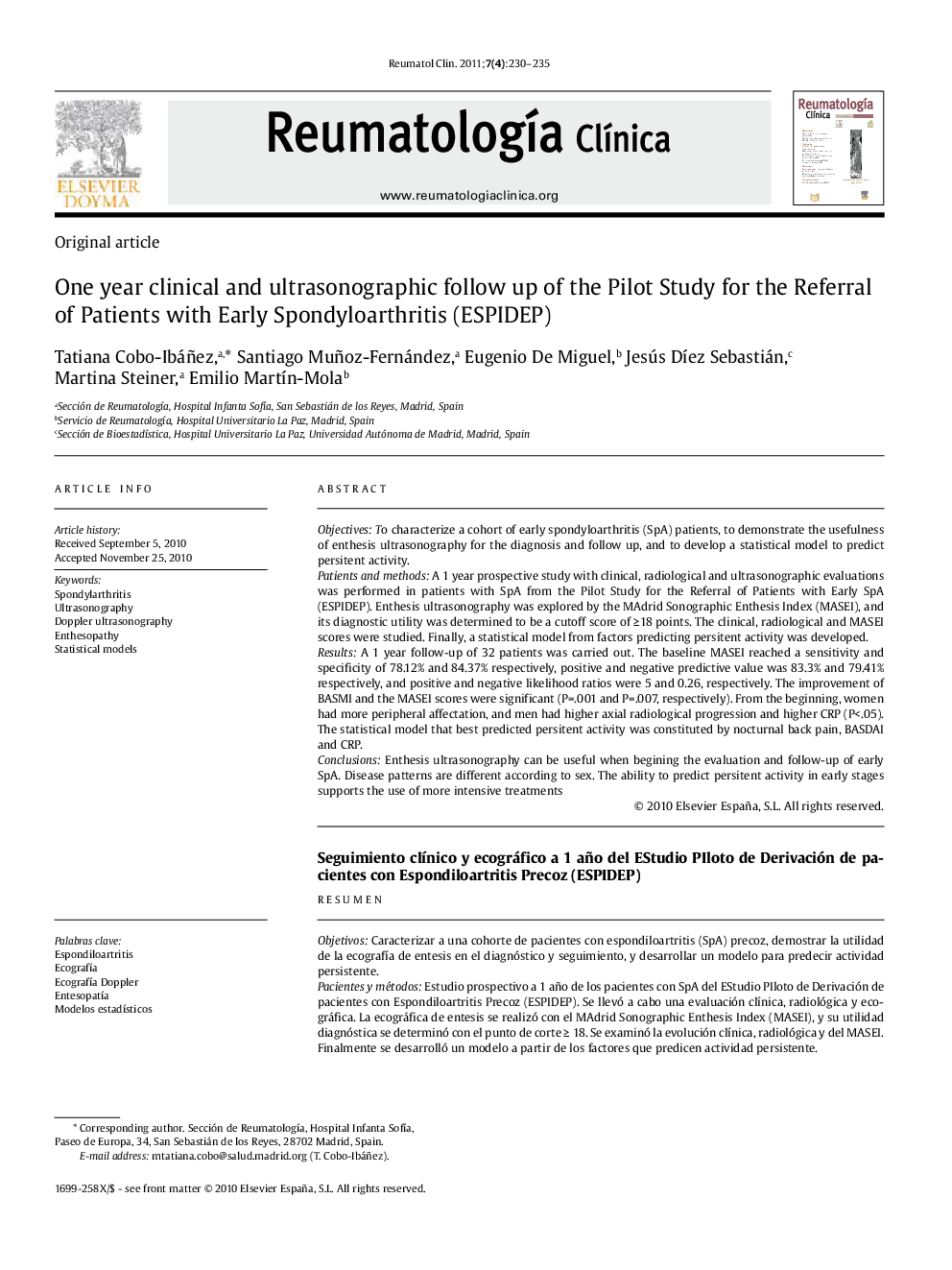| Article ID | Journal | Published Year | Pages | File Type |
|---|---|---|---|---|
| 3384837 | Reumatología Clínica (English Edition) | 2011 | 6 Pages |
ObjectivesTo characterize a cohort of early spondyloarthritis (SpA) patients, to demonstrate the usefulness of enthesis ultrasonography for the diagnosis and follow up, and to develop a statistical model to predict persitent activity.Patients and methodsA 1 year prospective study with clinical, radiological and ultrasonographic evaluations was performed in patients with SpA from the Pilot Study for the Referral of Patients with Early SpA (ESPIDEP). Enthesis ultrasonography was explored by the MAdrid Sonographic Enthesis Index (MASEI), and its diagnostic utility was determined to be a cutoff score of ≥18 points. The clinical, radiological and MASEI scores were studied. Finally, a statistical model from factors predicting persitent activity was developed.ResultsA 1 year follow-up of 32 patients was carried out. The baseline MASEI reached a sensitivity and specificity of 78.12% and 84.37% respectively, positive and negative predictive value was 83.3% and 79.41% respectively, and positive and negative likelihood ratios were 5 and 0.26, respectively. The improvement of BASMI and the MASEI scores were significant (P=.001 and P=.007, respectively). From the beginning, women had more peripheral affectation, and men had higher axial radiological progression and higher CRP (P<.05). The statistical model that best predicted persitent activity was constituted by nocturnal back pain, BASDAI and CRP.ConclusionsEnthesis ultrasonography can be useful when begining the evaluation and follow-up of early SpA. Disease patterns are different according to sex. The ability to predict persitent activity in early stages supports the use of more intensive treatments
ResumenObjetivosCaracterizar a una cohorte de pacientes con espondiloartritis (SpA) precoz, demostrar la utilidad de la ecografía de entesis en el diagnóstico y seguimiento, y desarrollar un modelo para predecir actividad persistente.Pacientes y métodosEstudio prospectivo a 1 año de los pacientes con SpA del EStudio PIloto de Derivación de pacientes con Espondiloartritis Precoz (ESPIDEP). Se llevó a cabo una evaluación clínica, radiológica y ecográfica. La ecográfica de entesis se realizó con el MAdrid Sonographic Enthesis Index (MASEI), y su utilidad diagnóstica se determinó con el punto de corte ≥ 18. Se examinó la evolución clínica, radiológica y del MASEI. Finalmente se desarrolló un modelo a partir de los factores que predicen actividad persistente.ResultadosSe realizó el seguimiento durante 1 año a 32 pacientes. El MASEI basal alcanzó una sensibilidad y especificidad de 78,12% y 83,37%, un valor predictivo positivo y negativo del 83,3% y el 79,41%, y una razón de verosimilitud positiva y negativa de 5 y 0,26, respectivamente. La mejoría del BASMI y el MASEI fue significativa (p = 0,001 y p = 0,007, respectivamente). Las mujeres tuvieron más afectación periférica desde el inicio y los hombres mayor progresión radiológica axial y PCR más elevada (p < 0,05). El modelo que mejor predijo actividad persistente estaba formado por dolor axial nocturno, BASDAI y PCR.ConclusionesLa ecografía de entesis puede ser útil en la evaluación inicial y el seguimiento de las SpA precoces. El patrón de enfermedad difiere según el sexo. Predecir actividad persistente en estadios precoces apoya la utilización de tratamientos más intensivos.
